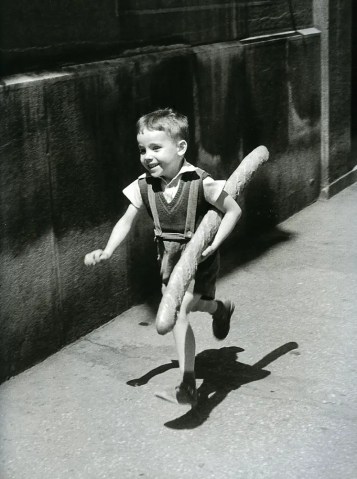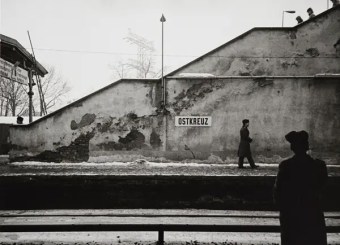You know those famous photographers everyone’s always squawking about? Bresson, Ansel Adams, Daidō Moriyama, uh… Eric Kim? Well this isn’t about them. They’re covered ad nauseam and we know you’re tired of hearing the same old. So today we’re going to talk about a handful of lesser-known photographers whose work you should study, and whose stories you should know. When we say “lesser-known,” these aren’t obscure nobodies – these are pro photogs from the heyday of film who are known to real photo geeks, but for whatever reason, don’t seem to get mentioned on the photo-blogosphere as often as those other guys.
Let’s get squawking.
Ray K. Metzker
Metzker was a photographer whose work defied categorization. With a career spanning more than four decades, this is unsurprising. Displayed in more than fifty public collections, including some of the most prestigious museums in the world, his work has been described as “complex” and “terrifically different.” Perhaps his most famous work was a series of composites that he produced over a span of more than twenty years. These pieces are composed of multiple superimposed, combined, and repeated frames of 35mm film packed into a single image. They’re dense, mysterious, loaded with contrast, and worth examination. See more here, or buy the book.
Eikoh Hosoe
One of the most notable post-war Japanese photographers, Hosoe’s work began in the mid-1950s and continued for decades. Known for his use of symbolism and the psychologically charged images he produced, Hosoe was at the forefront of the experimental arts movement that followed World War II. His work often took the form of collaborations with well-known figures, such as Yukio Mishima, the writer who famously formed a militia and committed ritual suicide by seppuku when the coup d’état he spurred failed to restore the Emperor’s pre-war authority. Other collaborations involved the dancer Tatsumi Hijikata embodying the role of a supernatural ghost who wanders the Japanese countryside. This haunting, puzzling, and sometimes frightening series, called Kamaitachi, follows this ghost and chronicles its encounters with local farmers and children. This work was groundbreaking when it was first produced, and even today there’s very little out there that can compete with Hosoe’s obtusely unnerving originality.
Robert Landsburg
Though Robert Landsburg no doubt shot countless rolls of film in his career as a photographer, his most famous is the final roll, which tells a story of dedication to the noblest ideals of photojournalism. In the first half of May, 1980, Landsburg was on assignment shooting the changing face of Mount St. Helens, a volcano located in the state of Washington. On the morning of May 18th he was just a few miles from the summit with his camera and tripod when an earthquake rocked the site and caused the entire north face to break away. The ensuing avalanche tumbled down the mountain, followed by a massive pyroclastic flow. Landsburg saw the eruption and the enormous wall of superheated ash that was now pouring his way. He fired as many shots as he could, then famously rewound the film, loaded the camera into his backpack, and apparently laid himself upon the pack to preserve his film. His body was found seventeen days later, his pack beneath him. The film was processed and the photos and accompanying story of Landsburg’s final moments were published in the January 1981 issue of National Geographic.
Willy Ronis
Pretty famous in his own right, at least amongst photographers, Ronis’ story is the stuff of romantic legend. Born in 1910, his first thirty-odd years were spent in the family business (a photography studio) where he met and befriended legends Robert Capa, Bresson, and David Seymour. In the mid-thirties he became a freelance shooter, producing his first collection of work with a Rolleiflex. The next decade would find him fleeing Nazi occupation, traveling with a theatre troupe, and courting his future wife. In the mid-’40s he returned to France to photograph returning war-prisoners and deportees, and then spent the rest of his life taking magically humanistic photos that would appear in books, galleries, and LIFE magazine. His work shows the deeply human side of life in Paris, life during war, and life in peace. Most striking, and worth emulation, is his humility and respect for the people in his photos. “I never took a mean photo,” he once told the Associated Press, adding, “I always had a lot of respect for the people I photographed.”
Ulrich Wüst
Wüst, who for a long while was mostly unknown in the West prior to the fall of the Berlin Wall, is now known as one of the most important photographers to come from the German Democratic Republic. His work, begun in the 1970s, evolved over the subsequent three decades into a powerful examination of Socialist life, and a critique of the East German way of city planning. But while we might assume all of these images would be stark and dour, which they sometimes are, the opposite is also true. Wüst’s images also show the private lives of non-conformists in a nearly hermetically sealed society. His photography in the era of reunification, while completely different, is just as interesting.
So many photographers, so little time. Let us know in the comments if we’ve showcased one of your favorites, and tell us which photographers really inspire you.
Looking for more inspiration?
Shop photography books on Amazon
Shop photography books on B&H Photo
Follow Casual Photophile on Facebook and Instagram
[Some of the links in this article will direct users to our affiliates at B&H Photo, Amazon, and eBay. By purchasing anything using these links, Casual Photophile may receive a small commission at no additional charge to you. This helps Casual Photophile produce the content we produce. Many thanks for your support.]

















Great list, nice to see something a bit different than the usual ones you find everywhere else.